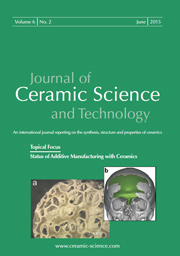Articles
All articles | Recent articles
Ytterbia-Neodymia Costabilized Zirconia – Alumina Nanocomposites
F. Kern
University of Stuttgart, Institute for Manufacturing Technologies of Ceramic Components and Composites, D-70569 Stuttgart, Allmandring 7B
received June 12, 2012, received in revised form September 19, 2012, accepted October 2, 2012
Vol. 3, No. 4, Pages 189-198 DOI: 10.4416/JCST2012_00021
Abstract
Alumina-toughened zirconia composites are attractive materials for biomedical and demanding mechanical engineering applications as the added alumina increases hardness and strength while the fracture toughness of zirconia is preserved. In the present study an unstabilized pyrogenic zirconia nanopowder was coated with 1 mol% ytterbia and 2 mol% neodymia via the nitrate route, the powder was blended with 20 vol% submicron size alumina. Samples were hot-pressed at 1250 – 1450 °C for 1 h at 60 MPa axial pressure. Microstructure, phase composition and mechanical properties were investigated. The composites show proceeding phase separation with rising sintering temperature. Cubic precipitates are formed, leaving a highly transformable tetragonal zirconia matrix, which results in a combination of very high fracture resistance, threshold stress intensity and bending strength. The material thus combines high resistance to catastrophic failure in single loading events and good prospects for applications operating under cyclical loading conditions.
![]() Download Full Article (PDF)
Download Full Article (PDF)
Keywords
Ceramics, mechanical properties, phase composition, microstructure
References
1 Kelly, P.M., Rose, L.R.F.: The martensitic transformation in ceramics – its role in transformation toughening, Prog. Mater. Sci., 47, 463 – 557, (2002).
2 Hannink, R.H.J., Kelly, P.M., Muddle, B.C.: Transformation toughening in zirconia-containing ceramics, J. Am. Ceram. Soc., 83, [3], 461 – 87, (2000).
3 Chevalier, J., Gremillard, L., Virkar, A.V., Clarke, D.R.: The tetragonal-monoclinic transformation in zirconia: lessons learned and future trends, J. Am. Ceram. Soc., 92. [9], 1901 – 20, (2009).
4 Swain, M.V., Rose, L.R.F.: Strength limitations of transformation-toughened zirconia alloys, J. Am. Ceram. Soc., 69, [7], 511 – 18, (1986).
5 Li, P., Chen, I.W., Penner-Hahn, J.E.: Effect of dopants on zirconia stabilization – an X-ray absorption study: I, trivalent dopants, J. Am. Ceram. Soc., 77, [1], 118 – 28, (1994).
6 Li, P., Chen, I.W., Penner-Hahn, J.E.: Effect of dopants on zirconia stabilization – an X-ray absorption study: II, tetravalent dopants, J. Am. Ceram. Soc., 77, [5], 1281 – 88, (1994).
7 Li, P., Chen, I.W., Penner-Hahn, J.E.: Effect of dopants on zirconia stabilization – an X-ray absorption study: III, charge-compensating dopants, J. Am. Ceram. Soc., 77, [5], 1289 – 95, (1994).
8 Mizutani, Y., Hisada, K., Ukala, K., Sumi, H., Yokoyama, M., Nakamura, Y., Yamamoto, O.: From rare earth doped zirconia to 1 kW solid oxide fuel cell system, J. Alloy. Comp., 408 – 412, 518 – 24, (2006).
9 Cao, X.Q., Vassen, R., Stoever, D.: Ceramic materials for thermal barrier coatings, J. Eur. Ceram. Soc., 24, [1], 1 – 10, (2004).
10 Nettleship, I., Stevens, R.: Tetragonal zirconia polycrystal (TZP) – a review, Int. J. High. Tech. Ceram., 3, [1], 1 – 32, (1987).
11 Singh, R., Gill, C., Lawson, B., Dransfield, G.P.: Sintering, microstructure and mechanical properties of commercial Y-TZPs, J. Mat. Sci., 31, 6055 – 62, (1996).
12 Ohnishi, H., Naka, H., Sekino, T., Ikuhara, Y., Niihara, K.: Mechanical properties of 2.0 – 3.5 mol-% Y2O3-stabilized zirconia polycrystals fabricated by the solid phase mixing and sintering method, J. Ceram. Soc. Jap., 116, [12], 1270 – 77, (2008).
13 Yuan, Z.X., Vleugels, J., Van der Biest, O.: Preparation of Y2O3-coated ZrO2 powder by suspension drying, J. Mat. Sci. Let., 19, 359 – 61, (2000).
14 Piconi, C., Burger, W., Richter, H.G., Cittadini, A., Maccauro, G., Covacci, V., Bruzzese, N., Ricci, G.A., Marmo, E.: Y-TZP ceramics for artificial joint replacements, Biomaterials, 19, 1489 – 94, (1998).
15 Kern, F.: Alumina-doped 2.5Y-TZP produced from yttria-coated pyrogenic nanopowder, J. Ceram. Sci. Tech., 2, [2], 89 – 96, (2011).
16 Ross, I.M., Rainforth, W.M., McComb, D.W., Scott, A.J., Brydson, R.: The role of trace additions of alumina to yttria-tetragonal zirconia polycrystals (Y-TZP), Scr. Mat., 45, 653 – 60, (2001).
17 Vleugels, J., Yuan, Z.X., Van der Biest, O.: Mechanical properties of Y2O3/Al2O3-coated Y-TZP ceramics, J. Eur. Ceram. Soc., 22, 873 – 81, (2002).
18 Tsukuma, K., Ueda, K., Shimada, M.: Strength and fracture toughness of isostatically hot-pressed composites of Al2O3 and Y2O3-partially-stabilized ZrO2, J. Am. Ceram. Soc., 68, [1], C4– C5, (1985).
19 Tsubakino, H., Sonoda, K., Nozato, R.: Martensite transformation behaviour during isothermal ageing in partially stabilized zirconia with and without alumina addition, J. Mat. Sci. Let., 12, 196 – 8, (1993).
20 Kan, Y., Li, S., Wang, P., Zhang, G.J., Van der Biest, O., Vleugels, J.: Preparation and conductivity of Yb2O3 – Y2O3 and Gd2O3 –-Y2O3 co-doped zirconia ceramics, Solid State Ionics, 179, 1531 – 4, (2008).
21 Kan, Y., Zhang, G.J., Wang, P., Van der Biest, O., Vleugels, J.: Yb2O3 and Y2O3 co-doped zirconia ceramics, J. Eur. Ceram. Soc., 26, 3607 – 12, (2006).
22 Huang, S.G., Li, L., Van der Biest, O., Vleugels, J.: Microwave sintering of CeO2 and Y2O3 co-stabilised ZrO2 from stabiliser-coated nanopowders, J. Eur. Ceram. Soc., 27, 689 – 93, (2007).
23 Vleugels, J., Xu, T., Huang, S., Kan, Y., Wang, P., Li, L., Van der Biest, O.: Characterization of (Nd,Y)-TZP ceramics prepared by a colloidal suspension coating technique, J. Eur. Ceram. Soc., 27, 1339 – 43, (2007).
24 Salehi, S., Van der Biest, O., Vleugels, J.: Y2O3 and Nd2O3 co-stabilized ZrO2-WC composites, J. Mat. Sci., 43, 5784 – 9, (2008).
25 Salehi, S., Yüksel, B., Vanmeensel, K., Van der Biest, O., Vleugels, J.: Y2O3 – Nd2O3 double stabilized ZrO2 – TiCN nanocomposites, Mat. Chem. Phys., 113, 596 – 601, (2009).
26 Salehi, S., Vanmeensel, K., Swarnakar, A.K., Van der Biest, O., Vleugels, J.: Hydrothermal stability of mixed stabilised tetragonal (Y, Nd)-ZrO2 ceramics, J. Alloys. Comp., 495, 556 – 60, (2010).
27 Gadow, R., Kern, F.: Novel zirconia-alumina nanocomposites combining high strength and toughness, Adv. Eng. Mat., 12, [12], 1220 – 3, (2010).
28 Kern, F.: High toughness and strength in yttria-neodymia costabilized zirconia ceramics, Scr. Mat., (2012); http://dx.doi.org/10.1016/j.scriptamat.2012.05.009.
29 Kern, F., Gadow, R.: Ytterbia (2.25 mol.%) stabilised zirconia (Yb-TZP) manufactured from coated nanopowder, Adv. Appl. Ceram., (2012); http://dx.doi.org/10.1179/1743676111Y.0000000071.
30 Kern, F.: 2.75Yb-TZP ceramics with high strength and aging resistance, J. Ceram. Sci. Tech., 2, [3], 147 – 54, (2011).
31 Kern, F.: Gadolinia-Neodymia-costabilized zirconia materials with high toughness and strength, J. Ceram. Sci. Tech., (2012) submitted.
32 Toraya, H., Yoshimura, M., Somiya, S.: Calibration curve for quantitative analysis of the monoclinic-tetragonal ZrO2 system by X-ray diffraction, J. Am. Ceram. Soc., 67, [6], C119 – 121, (1984).
33 Anstis, G.R., Chantikul, P., Lawn, B.R., Marshall, D.B.: A critical evaluation of indentation techniques for measuring fracture toughness: I, direct crack measurements, J. Am. Ceram. Soc., 64, [9], 533 – 538, (1981).
34 Chantikul, P., Anstis, G.R., Lawn, B.R., Marshall, D.B.: A critical evaluation of indentation techniques for measuring fracture toughness: II, strength method, J. Am. Ceram. Soc., 64, [9], 539 – 543, (1981).
35 Braun, L.M., Benninson, S.J., Lawn, B.R.: Objective evaluation of short-crack toughness curves using indentation Flaws: case study on alumina-based ceramics, J. Am. Ceram. Soc., 75, [11], 3049 – 57, (1992).
36 Dransmann, G., Steinbrech, R., Pajares, A., Guiberteau, F., Dominguez-Rodriguez, A., Heuer, A.: Indentation studies on Y2O3,-stabilized ZrO2: II, toughness determination from stable growth of indentation-induced cracks, J. Am. Ceram. Soc., 77, [5], 1194 – 201, (1994).
37 Benzaid, R., Chevalier, J., Saadaoui, M., Fantozzi, G., Nawa, M., Diaz, L.A., Torrecillas, R.: Fracture toughness, strength and slow crack growth in a ceria-stabilized zirconia-alumina nanocomposite for medical applications, Biomaterials, 29, 3636 – 3641, (2008).
38 Lube, T., Fett, T: A threshold stress intensity factor at the onset of stable crack extension of knoop indentation cracks, Eng. Fract. Mech., 71, 2263 – 2269, (2004).
39 Kern, F., Gadow, R.: Alumina-toughened zirconia from yttria-coated powders, J. Eur. Ceram. Soc., (2012); http://dx.doi.org/10.1016/j.jeurceramsoc.2012.03.014
40 Virkar, A.V., Matsumoto, R.L.K.: Ferroelastic domain switching as a toughening mechanism in tetragonal zirconia, J. Am. Ceram. Soc., 69, [10], C224 – C226, (1986).
41 McMeeking, R.M., Evans, A.G.: Mechanics of transformation-toughening in brittle materials, J. Am. Ceram. Soc., 65, [5], 242 – 6, (1982).
42 Kosmac, T., Wagner, R., Claussen, N: X-ray determination of transformation depths in ceramics containing tetragonal ZrO2, J. Am. Ceram. Soc., 64, [4], C72 – 73, (1981).
43 Budiansky, B., Hutchinson, J.W., Lambropolous, J.C.: Continuum theory of dilatant transformation toughening in ceramics, Int. J. Solids Struct., 19, [4], 337 – 55, (1983).
44 Wang, C., Zinkevich, M., Aldinger, F: Phase diagrams and thermodynamics of rare-earth-doped zirconia ceramics, Pure Appl. Chem., 79, [10], 1731 – 1753, (2007).
45 Matsui, K., Yoshida, H., Ikuhara, Y.: Isothermal sintering effects on phase separation and grain growth in yttria-stabilized tetragonal zirconia polycrystal, J. Am. Ceram. Soc., 92, [2], 467 – 75, (2009).
46 Burger, W., Richter, H.G., Piconi, C., Vatteroni, R., Cittadini, A., Boccalari, M.: New Y-TZP powders for medical grade zirconia, J. Mat. Sci.-Mater. M., 8, 113 – 118, (1997).
47 Matsui, K., Horikoshi, H., Ohmichi, N., Ohgai, M., Yoshida, H., Ikuhara, Y: Cubic-formation and grain-growth mechanisms in tetragonal zirconia polycrystal, J. Am. Ceram. Soc., 86, [8], 1401 – 1408, (2003).
48 Suto, H., Sakuma, T., Yoshikawa, N.: Discussion on the phase diagram of Y2O3-partially stabilized zirconia and interpretation of the structures, Transact. Jap. Inst. Metals, 28, [8], 623 – 30, (1987).
49 Chen, M., Hallstedt, B., Gauckler, L.J.: Thermodynamic modeling of the ZrO2 – YO1.5 system, Solid State Ionics, 170, 255 – 274, (2004).
50 Evans, A.G: Perspective on the development of high toughness ceramics, J. Am. Ceram. Soc., 73, [2], 187 – 206, (1990).
51 Fünfschilling, S., Fett, T., Oberacker, R., Hoffmann, M.J., Schneider, G.A., Becher, P.F., Kruzic, J.J.: Crack-tip toughness from vickers crack-tip opening displacements for materials with strongly rising R-curves, J. Am. Ceram. Soc., 94, [6], 1884 – 1892, (2011).
52 Cuadrado, N., Casellas, D., Anglada, M., Marro, F.G.: Fracture toughness evaluation by crack-opening displacement of cube-corner indenters, In: Proceedings of the 13th interregional conference on ceramics CIEC13, Universitad Polytécnica de Catalunya, Barcelona, Spain, (2012).
53 Krell, A.: Features of notch preparation for fracture toughness measurements in partially stabilized zirconia, J. Am. Ceram. Soc., 77, [2], 600 – 602, (1994).
54 Wang, J., Rainforth W.M., Wadsworth, I., Stevens, R: The effects of notch width on the SENB toughness for oxide ceramics, J. Eur. Ceram. Soc., 10, [1], 21 – 31, (1992).
Copyright
Göller Verlag GmbH


